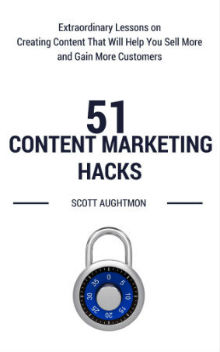Last year, my youngest son was in Kindergarten.
One of the things they taught the kids was how to recognize patterns.
They would have to be able recognize and name the basic types of patterns.
They had to be able to notice “AB” patterns (like the one in the image above that is yellow, orange, yellow, orange, etc.).
They had to recognize “ABC” patterns such as: blue, green, red, blue, green, red, etc.
And they had to recognize other types of patterns.
Why did they have to learn this? Because being able to recognize patterns in life is an important life skill.
But do you realize that the ability to recognize and form patterns is a powerful tool in content creation and content marketing?
You see, people crave familiar things – especially in a world like we live in today with so much turmoil and upheaval.
Patterns create a familiar framework that enables people to more easily consume your content.
Patterns Do Two Things That Are Important In Content Marketing:
1. They help people to follow along
2. They create anticipation
Now, obviously, when I am talking about creating content based on patterns I am NOT suggesting that you to create content that is predictable.
I am just saying that it should have an underlying pattern.
Let me show you what I mean with a three examples: one from a popular kid’s show, one from a reality show, and one from a blog.
Ready? Here we go…
1) Kids’ Show – Elmo’s World
This is an example of kid’s content, but you need to realize this show created one of the most popular children’s characters that ever has existed – a character that’s made millions of dollars.
How did Elmo’s creator do it?
Kevin Clash created a short show (Elmo’s World) within a show (Sesame Street) that harnessed the power of patterns.
He did this by coming up with a basic pattern that each show follows. Here is a sample of the pattern:
1. It’s an approximately 20 minute long episode that airs at the end of Sesame Street and stars Elmo.
2. Each shows focuses on a different topic such as: Babies, Balls, Pets, etc.
3. It always starts with the “Elmo’s World” song.
4. Elmo always greets the kids and tell’s them that “Elmo is so glad to see you today… And so is Dorothy (his goldfish)! Say, ‘Hello,’ Dorothy!” Then Elmo says, “Guess what Elmo’s thinking about today… Tadadada… _____________!” And then he reveals the topic.
5. Elmo then says, “Dorothy has a question,” which is always about the topic for the day.
6. Then they cut to a video segment with “The Noodle Family” which consists of Mr. Noodle, his brother known as “Mr. Noodle’s Brother,” and his sister “Ms. Noodle.” They try to answer the question, but they aren’t so smart, so it’s really just for humor and to get the kids watching to answer correctly.
7. Next usually comes a “Kids and baby” segment where various kids answer Dorothy’s question until they finally ask a baby (who doesn’t ever answer and causes Elmo to laugh).
From there the show goes on and cuts to different series of skits and interviews that are focused on that topic. The skits and interviews are basically the same every day – just the subject matter changes.
Why do they use a repetitive pattern?
“Research has shown that the formula appeals to young children’s attraction to ritual and routine, and that children’s participation with the program increases with repetition.”
I don’t believe that this is just true for kids. It’s also true for adults too.
Of course, the pattern needs to be more subtle, but adults still crave patterns and routine in their content.
The rest of my examples prove this point.
2. Reality Show – Pawn Stars
Each episode of this very popular History Channel show follows a pattern.
Let me share with you the basic pattern:
1. The show starts with the opening music and Rick Harrison doing a voice over about the shop.
2. The show has multiple segments with a person coming into the store to present something they want to pawn or sell (usually sell).
3. Rick or one of the other cast members asks, “How can I help you?“
4. The visitor presents what they have brought.
5. Rick then asks, “How much do you want for it?” and the visitor shares an amount they hope to get for it.
6. Rick usually counters with a lower price and they go back and forth until they come up with a price they agree on. (Or they don’t agree and the visitor leaves with their item.)
7. Another part of the pattern is that someone usually brings in something that Rick needs to bring one of his expert friends in to evaluate, because he doesn’t know its value or legitimacy.
8. Another common pattern is that one of the guys who works there, known as “Chumley,” is featured in a segment and usually adds comic-relief with his comments.
9. They also occasionally test out a larger item they have purchased outdoors. These would be things like jeeps, cannons, guns, etc.
With a small amount of variation, this is how the show “Pawn Stars” always goes. Do you see how this show is really no less formulaic than Elmo’s World? Why?
Because adults need/want patterns in the content they consume just like kids do!
3. Blog – Copyblogger
As you probably know, Copyblogger.com, has an extremely popular blog that helps people to learn how to use content to get traffic, attract links, and ultimately grow revenue and profits.
And, if you look closely, you can see Copyblogger uses patterns on a macro-level and on a micro level.
- The Macro-level patterns would be the patterns they use on a blog as a whole.
- The Micro-level patterns would be the patterns they use for a specific blog post.
Copyblogger’s Macro-level Pattern
Let’s just look at Copyblogger’s Macro-level pattern, which focuses on the site as a whole. By doing this, you can see a pattern that Copyblogger consistently uses on the blog itself.
The basic pattern for the type of posts they present on their blog looks something like this:
1. They will regularly present a post that will juxtapose a marketing idea with a seemingly unrelated – or even shocking – topic, item, or person.
Examples: “The Granola-Munching Hippie’s Guide to All-Natural SEO” or “What Michael Phelps’ 19th Olympic Medal Can Teach You About Smarter Online Marketing“
2. They will regularly present a type of post called “The Lede” where Robert Bruce presents links to valuable content across the internet.
Examples: “7 Must Read Copywriting and Marketing Links” or “7 Content Marketing Articles You Can Use“
3. They will regularly present posts from the key members of the Copyblogger team: Brian Clark and Sonia Simone.
4. They regularly create free “courses” that people can subscribe to be a part of.
Example: Grab Our Free Internet Marketing Course
5. They regularly present posts that feature their podcast called “Internet Marketing For Smart People Radio.”
Example: Seth Godin on When You Should Start Marketing Your Product, Service, or Idea
6. They regularly release a new product or re-release a previous product.
Example: StudioPress
This isn’t an exhaustive list of all the types of posts they do.
They regularly use other types of posts that feature tutorials, guest posts, etc., but you can see my point about patterns.
They are again using a predictable pattern, which creates “ritual and routine” for their readers. This causes they readers to continually come back for more because they love the pattern and know what to expect.
2 Ways Different Ways You Can Utilize Patterns To Create Effective Content
Now that you see the power of using macro-level or micro-level patterns while creating content, you now are ready to apply this yourself.
I want to share with you two ways you can utilize patterns to help you to more easily create effective content.
One way is to utilize external patterns to help you create more effective content:
1. Notice the patterns that other effective content creators and content marketers use.
2. Try out their patterns with your own content.
3. Study the results.
4. Use the patterns that you are the most comfortable with and that produce the best results.
The other way is to utilize internal patterns to help you create more effective content:
1. Notice the patterns you tend to already use when creating content.
2. Study which patterns seem to be get the best response and are well received.
3. Purposely use the patterns which you determine get the best response.
4 Benefits Of Using Patterns When Creating Content
1. It gives you a framework to start with, which helps you overcome “the blank page” syndrome that often causes writer’s block.
2. It allows you begin to create a style of content your reader can get used to and associate with you.
3. People who resonate with your pattern(s) begin to regularly come back because they like the format and know what to expect.
4. It gives you structure and freedom. Structure for the flow of your blog post, or types of posts you use, but freedom to be creative within that framework.
One Way I Do This
I don’t know if you noticed it before, but I have a pattern I use on a micro-level on this blog. Each blog post generally has a regular pattern I follow.
On a basic level the pattern looks like this:
1. I use something to grab your attention.
2. I present my main thoughts, ideas or lesson.
3. I challenge you to take action.
My Challenge For You
I have three simple challenges for you that will help you to apply this concept.
1. Begin to look for and record patterns that you and others seem to like. Go to your favorite sites and blogs and read their posts. Notice and make note of the patterns you see.
2. Notice the pattern(s) you tend to use by default.
3. Purposely implement one new pattern in your next blog post.
4. Analyze the results to decide if it’s a pattern people like.
(*I’ll be sharing more content boosting secrets in my upcoming “Content Boosters” course. Sign-up for a preview below.)
Comments or Questions?
As usual, if you have any comments or questions, then post them in the comments below or contact me here.
Related articles
- Want To Learn How To Boost Your Content? Sign-Up For A Preview Of My Upcoming “Content Boosters” Online Course (recessionsolution.com)
- How the Inc. 500 Fastest-Growing Companies Are Using Content Marketing (contentmarketinginstitute.com)
- Business & Branding Lessons From The Show “American Pickers” (recessionsolution.com)
CLICK HERE TO SIGN-UP FOR MY FREE “CONTENT BOOSTERS” PREVIEW LESSONS.
CLICK HERE TO SIGN-UP FOR MY “RECESSION SOLUTION BLOG” UPDATE LIST.







